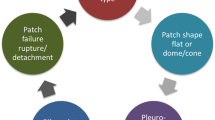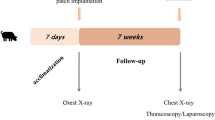Abstract
Patch closure is necessary to achieve tension-free repair in large congenital diaphragmatic hernia. However, the use of prosthetic material may lead to granulation, allergic reaction, infection, recurrence of hernia, and thoracic deformity. Tissue engineering may become an alternative treatment strategy for diaphragmatic hernia repair, since the regenerated autologous tissue is expected to grow potentially without rejection or infection. We evaluated the efficacy of diaphragmatic hernia repair in a rat model using a poly-lactic-co-glycolic acid (PLGA) mesh–collagen sponge hybrid scaffold, designed for in situ tissue engineering. Twenty-four F344 female rats were used. Oval-shaped defects were surgically created in the left diaphragm and repaired with three different grafts, including PLGA mesh in group 1 (n = 7), PLGA mesh–collagen sponge hybrid scaffold in group 2 (n = 7), and PLGA mesh–collagen sponge hybrid scaffold seeded with bone marrow-derived mesenchymal stem cells (MSCs) in group 3 (n = 10). The animals were killed at 1, 2, and 3 months after operation. The specimens were examined macroscopically and microscopically. No recurrence or eventration was observed. In all animals, autologous fibrous tissue with vascularization was generated at the graft site. Although no muscular tissue was detected, scattered desmin-positive cells were observed in groups 2 and 3. The ‘neodiaphragm’ in groups 2 and 3 was significantly thicker compared with that in group 1. There was no significant difference in the ‘neodiaphragm’ between groups 2 and 3. The PLGA mesh–collagen sponge hybrid scaffold provided better promotion of autologous in situ tissue regeneration in the diaphragm, suggesting its potential application to diaphragmatic repair in place of other prosthetic patches.


Similar content being viewed by others
References
Dalton ML Jr, Dixon RB, West RL (1966) Dacron diaphragmatic grafts. Am J Surg 111:668–672. doi:10.1016/0002-9610(66)90038-9
Geisler F, Gottleib A, Fried A (1977) Agenesis of the right diaphragm repaired with marlex. J Pediatr Surg 12:587–588. doi:10.1016/0022-3468(77)90204-4
Touloukian RJ (1978) A “new” diaphragm following prosthetic repair of experimental hemidiaphragmatic defects in the pup. Ann Surg 187:47–51. doi:10.1097/00000658-197801000-00009
Newman BM, Jewett TC, Lewis A, Cerny F, Khan A, Karp M et al (1985) Prosthetic materials and muscle flaps in the repair of extensive diaphragmatic defects: an experimental study. J Pediatr Surg 20:362–367. doi:10.1016/S0022-3468(85)80220-7
Lally KP, Cheu HW, Vazquez WD (1993) Prosthetic diaphragm reconstruction in the growing animal. J Pediatr Surg 28:45–47. doi:10.1016/S0022-3468(05)80352-5
Clark RH, Hardin WD Jr, Hirschl RB, Jaksic T, Lally KP, Langham MR Jr et al (1998) Current surgical management of congenital diaphragmatic hernia: a report from the Congenital Diaphragmatic Hernia Study Group. J Pediatr Surg 33:1004–1009. doi:10.1016/S0022-3468(98)90522-X
Kimber CP, Dunkley MP, Haddock G, Robertson L, Carey FA, Cuschieri A (2000) Patch incorporation in diaphragmatic hernia. J Pediatr Surg 35:120–123
Saltzman DA, Ennis JS, Mehall JR, Jackson RJ, Smith SD, Wagner CW (2001) Recurrent congenital diaphragmatic hernia: a novel repair. J Pediatr Surg 36:1768–1769. doi:10.1053/jpsu.2001.28818
Koot VCM, Bergmeijer JG, Molenaar JC (1993) Lyophylized dura patch repair of congenital diaphragmatic hernia: occurrences of relapses. J Pediatr Surg 28:667–668. doi:10.1016/0022-3468(93)90027-I
Sydorak RM, Hoffman W, Lee H, Yingling CD, Longaker M, Chang J et al (2003) Reversed latissimus dorsi muscle flap for repair of recurrent congenital diaphragmatic hernia. J Pediatr Surg 38:296–300. doi:10.1053/jpsu.2003.50097
Scaife ER, Johnson DG, Meyers RL, Johnson SM, Matlak ME (2003) The split abdominal wall muscle flap—a simple, mesh-free approach to repair large diaphragmatic hernia. J Pediatr Surg 38:1748–1751. doi:10.1016/j.jpedsurg.2003.08.045
Rosenkrantz JG, Cotton EK (1964) Replacement of left hemidiaphragm by a pedicled abdominal muscular flap. J Thorac Cardiovasc Surg 48:912–920
Moss RL, Chen CM, Harrison MR (1992) Prosthetic patch durability in congenital diaphragmatic hernia: a long-term follow-up study. J Pediatr Surg 27:754–756. doi:10.1016/S0022-3468(05)80109-5
Fauza DO, Marler JJ, Koka R, Forse RA, Mayer JE, Vacanti JP (2001) Fetal tissue engineering: diaphragmatic replacement. J Pediatr Surg 36:146–151. doi:10.1053/jpsu.2001.20034
Dalla Vecchia L, Engum S, Kogon B, Jensen E, Davis M, Grosfeld J (1999) Evaluation of small intestine submucosa and acellular dermis as diaphragmatic prostheses. J Pediatr Surg 34:167–171. doi:10.1016/S0022-3468(99)90250-6
Sandoval JA, Lou D, Engum SA, Fisher LM, Bouchard CM, Davis MM et al (2006) The whole truth: comparative analysis of diaphragmatic hernia repair using 4-ply vs 8-ply small intestinal submucosa in a growing animal model. J Pediatr Surg 41:518–523. doi:10.1016/j.jpedsurg.2005.11.068
Chen G, Ushida T, Tateishi T (2000) A hybrid network of synthetic polymer mesh and collagen sponge. Chem Commun (Camb) 16:1505–1506. doi:10.1039/b003508o
Tateishi T, Chen G, Ushida T (2002) Biodegradable porous scaffolds for tissue engineering. J Artif Organs 5:77–83. doi:10.1007/s100470200014
Lennon DP, Caplan AI (2006) Isolation of rat marrow-derived mesenchymal stem cells. Exp Hematol 34:1606–1607. doi:10.1016/j.exphem.2006.07.015
Ramadwar RH, Carachi R, Young DG (1997) Collagen-coated Vicryl mesh is not a suitable material for repair of diaphragmatic defects. J Pediatr Surg 32:1708–1710. doi:10.1016/S0022-3468(97)90510-8
Acknowledgments
This work was supported by Grant-in-Aids from the Japan Society for the Promotion of Science.
Author information
Authors and Affiliations
Corresponding author
Rights and permissions
About this article
Cite this article
Urita, Y., Komuro, H., Chen, G. et al. Evaluation of diaphragmatic hernia repair using PLGA mesh–collagen sponge hybrid scaffold: an experimental study in a rat model. Pediatr Surg Int 24, 1041–1045 (2008). https://doi.org/10.1007/s00383-008-2212-y
Accepted:
Published:
Issue Date:
DOI: https://doi.org/10.1007/s00383-008-2212-y




